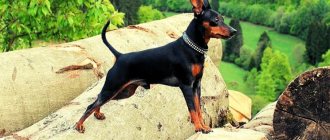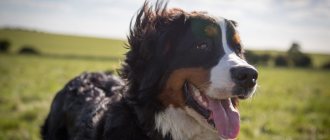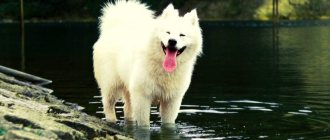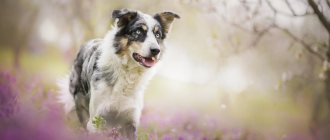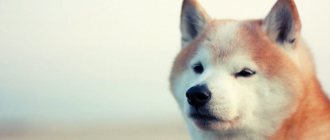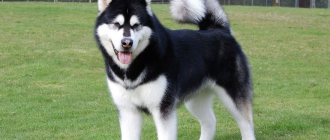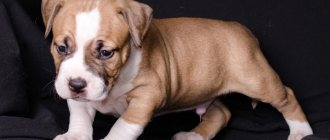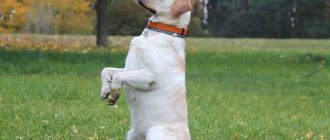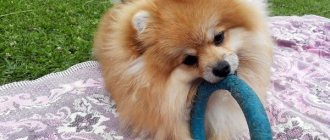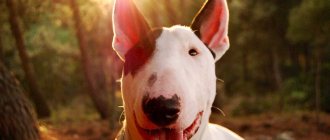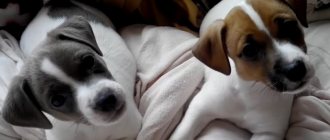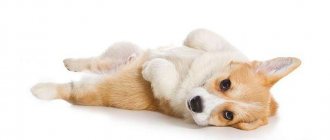Raising a dog is about developing correct behavior. This is the basis for successful training. Training is a set of activities aimed at training specific teams. It is necessary to start raising a puppy from the very first days of his appearance in the house. If you work with your pets from a very early age, then you are on the right track.
The American Akita Inu is a large and powerful breed of dog with a noble and intimidating appearance. The ancestors are Japanese Akitas, which were used to guard royalty and nobility in feudal Japan. The dogs tracked and hunted wild boars, bears, and sometimes deer. Akita does not back down from a challenge. They are fearless and loyal guards. They tend to be stubborn and will not tolerate strangers on their territory. While all of these qualities make for an excellent guard dog, they will also require an experienced owner.
- Country of Origin : USA
- Height at withers : male – 71-76 cm, female – 68-71 cm
- Weight : 32-59 kg
- Lifespan : 10-14 years
- Use : companion dog, guard dog
Description of the American Akita breed
The American Akita is a beautiful and distinctive dog that looks like a cute bear cub. If you have at least once seen an American Akita in a photo or in person, you will never be able to confuse it with another breed. In addition to the fact that these dogs are quite large, they are famous for their massive bones. Their muzzle is similar to that of a bear. And height and weight depend on gender.
Males at the withers reach 71 centimeters and weigh from 45 to 65 kilograms. Bitches are slightly shorter, so their height varies from 61 to 66 centimeters. And the weight can be from 32 to 45 kilograms.
Photo of American Akita
Head
Head. Large, massive, but proportionally built. In a calm state, there are completely no folds on it. If you look at the head from above, its shape will look like an obtuse triangle. The skull is flattened and there is a small groove on the forehead. Stop with a soft transition.
Muzzle. Big and wide. The ratio of its length to the length of the entire skull is 2:3.
Ears. In relation to the head of small size. They have a triangular shape and a standing position. There are wide cartilages at the base. The tips of the ears are slightly rounded. Not set low with a slight tilt forward. In a well-built dog, the tip of the ear should reach the upper eyelid when pressed against it. And if you look at the head from the side, the ears will continue the line of the neck.
Nose. The lobe is large, black. The nostrils are wide. Dogs with white fur may have brown lobes.
Mouth. The jaws are square-shaped and quite powerful. But the suspension is light.
Teeth. Strong and large. Scissor bite. A straight bite is also allowed by the breed standard. The dental formula is complete.
Lips. Fits tightly to the teeth, black in color.
Eyes. Small size relative to the head. They are planted deeply and have a shape close to a triangle. The iris is a rich chocolate shade. The eyelids are painted black and fit tightly to the whites of the eyes.
Neck. Well muscled, short. The suspension is small. The neck widens towards the shoulders. The scruff is clearly defined and smoothly blends into the skull.
Frame
Frame. Its length is greater than the height at the withers. The stomach is tucked, the back is straight. The loin is slightly convex and quite powerful. The skin does not sag.
Breast. The length is equal to half the height of the dog at the withers. The ribs are quite convex and can be easily felt.
Tail. Straight, overgrown with coarse hair, without dewlap. At the base it is wider and more powerful. Set on high, when walking it is located above the back. May touch the thigh during movement. The end of the tail reaches the back or below. Curved into a ring or several. When deployed, it reaches the hock joints.
Limbs
Front. With strong bones. If you look at the dog from the side, they look straight. The shoulders are well muscled, with strong and powerful shoulder blades. The elbows can only be directed back; everything else in the breed is considered a defect. The pasterns are slightly inclined. The paws are round in shape, similar to those of a cat. The pads are fleshy, the claws are strong.
Rear. With strong bones and developed muscles. Hips are powerful. The hocks are low and stand straight. If you look at the dog from behind, the knee joints are parallel. Their angles are not clearly expressed.
Wool
The American Akita has a densely packed, thick undercoat as well as guard hair. He is rough and tough. The undercoat is soft and slightly shorter than the topcoat.
On the paws, head and ears the fur is densely packed, but it is short. The length of the hair at the withers is about five centimeters. On other parts of the body it is slightly longer, especially when it comes to the tail.
Colors
The standard for this breed was adopted in 2000. According to him, the American Akita can have a lot of different shades of coat. Any color that is close to red, red or fawn is considered acceptable.
The dog may be spotted, brindle, or completely white. For spotted animals, the dominant color should be white. The spots should not occupy more than a third of the entire surface of the body and are mostly located in the head area.
The color of the American Akita's undercoat can be the same color as the coat or different from it. Some dogs have a groove, dark marking, or mask on their face.
Photos of American Akita colors
Mating
Before breeding an American Akita, the female must be prepared. First of all, get vaccinated. Manipulations are carried out 1 month before the planned estrus. Vaccination will strengthen the dog’s immunity and eliminate the risk of complications.
If vaccinations are not necessary, then be sure to give an anthelmintic to prevent parasites. Anti-tick and flea medications are allowed to be used no later than 2 weeks before mating.
Mating is carried out 2 times to ensure fertilization.
Ideally, 2-3 weeks before the heat, the dogs should be introduced and walked together. When the time comes for mating, the female will behave more favorably towards her partner.
Note! It is important to choose a secluded place, without other animals and people who might disturb your pets
Character of the American Akita
The American Akita is more obedient and sociable; it obeys a person rather than puts itself on an equal level with him. However, its respect must be earned, so training a dog must begin from birth. Since this is an intelligent breed that does not accept monotony and meaningless obedience, it may require the help of a specialist to train it.
It is also necessary to attend to the socialization of the dog early, but it is important to understand that this will not relieve him of the desire to dominate. The American Akita does not get along very well with other pets, especially those of the same sex. The voice of her hunting ancestors has not ceased, so cohabitation with small animals can be difficult.
Akitas are not aggressive, they like to be the center of attention, but they are not demanding and are sympathetic to the owner’s desire to relax and be alone. They get along well with children only if the kids respect them.
The American Akita will never make a fuss over trifles. This is a discreet dog that does not bark when it hears rustling or footsteps. She senses the line between real danger or threat and other sounds. If you get a dog of this breed in a high-rise building, you don’t have to worry about conflicts with neighbors. The animal will not bark and howl constantly without a good reason. And if someone hears something like this, then there is no doubt that the dog is giving an “alarm signal.”
These dogs do not tend to fuss, since nobility is in their blood. They do not bother or bother the owner, especially if he is busy or not inclined to communicate. Dogs subtly sense a person’s mood and have developed empathy. The American Akita needs personal space. Therefore, he can have a great time alone with himself.
Another distinctive feature of the American Akita is its touchiness. Not for nothing, of course. But if the owner raises his voice at the dog or uses physical force against it, then his authority will be instantly undermined. This dog will remember this attitude for a long time and may never forgive it. This may cause problems with obedience and training in the future.
What to encourage?
Before you start training, you need to prepare incentives.
Reinforcement will be a treat for your pet, which can be finely chopped pieces of food that the dog likes but does not eat regularly. For example, pieces of cheese, cooked or raw meat (chicken breast, beef, liver).
The younger the dog is, the smaller the size of the piece should be, but no more than 1-1.5 cm, so that the pet is not distracted from chewing food.
Education and training
The training of the American Akita should be approached taking into account the character traits of this breed. She is naturally characterized by such traits as stubbornness, pride and self-esteem.
These dogs do not tolerate prolonged intellectual and physical stress. Therefore, in order to achieve success in training, you should not only select the right time for classes, but also make them fractional. That is, it is better to study more often and little by little than to allocate half a day for this once a month. In addition, the American Akita needs leisurely activities; it does not tolerate fuss. She carries out commands thoughtfully, so be patient. Your pet may need time to learn and remember certain actions that you require of him.
If you want to turn your American Akita against you, the best training is yelling and physical punishment. Excessive severity and aggression can make the animal uncontrollable, cowardly and unpredictable. After such methods of education, the dog’s psyche will be disturbed and, most likely, it will pose a danger to you and others.
To train your American Akita correctly, you will need patience and persistence. This dog will definitely help you learn self-control. First you need to establish a trusting relationship with the puppy and establish contact with him.
The American Akita can be trained as a sled dog or guard dog. But, no matter what “specialty” you choose for your dog, the first thing you need to do is learn the basic commands. The first could be:
- "Ugh!";
- "To me!";
- "Near";
- "Sit!";
- "Lie!";
- "Place!" and so on.
Such commands can be taught to an American Akita as early as two to three months of age. It is a mistake to believe that at this age the puppy is still too small. On the contrary, his inquisitive mind will allow him to “grab on the fly” all the information. And short joint exercises with the puppy help to establish friendly relations with him.
To increase your American Akita's interest in activities and also increase his level of motivation, use praise and treats. Showing genuine joy will show your puppy that you are pleased with his achievements. This will motivate him to work even harder.
Training an American Akita at home is not easy, but it is a doable task. If you are an inexperienced breeder and this is your first dog, then professional help from a dog handler will help you not to fall into despair. A good specialist will point out problems that may arise during training, and will also help you complete this or that course with your pet. Sometimes it is impossible to do without a dog handler, especially if the dog has behavioral disorders.
Many American Akitas suffer from sudden mood swings. One moment they were having fun and running around, and the next second they “withdrew into themselves” and became isolated. This feature should also not be ignored in the process of training a dog. But if you put in maximum effort and patience during the training process, you will get not only a devoted friend, but also a well-mannered and intelligent dog.
Basic mistakes
The main mistakes that owners make when training Akita Inu are as follows:
- rudeness, raising the voice, corporal punishment during training;
- delay in starting training (training begins at 6-7 months);
- the result is not consolidated properly (repetitions are necessary in different situations);
- rewards until the final action is completed or the exercise ends.
NOTE!
If you become the owner of this wonderful breed, get ready for responsible training that requires patience and endurance. With the right approach, the result will not keep you waiting long; you will get an obedient, faithful and well-mannered pet.
Maintenance and care
American Akita dogs are considered quite healthy: they have strong immunity and are not subject to weather influences. At the same time, like many breeds, they have a number of serious genetic diseases. For this reason, before purchasing a dog, it is necessary to study its pedigree. Thus, an Akita may suffer from hypothyroidism, a disease affecting the functioning of the thyroid gland. Due to a lack of hormones, the pet becomes sleepy and sad, it quickly gains weight, sheds heavily, and often shows causeless aggression.
Another hereditary problem that is common not only in Akitas, but also in dogs of different breeds is joint dysplasia. When walking, the animal experiences unbearable pain, from which only surgery can relieve it.
Despite the long hair and thick undercoat, the American Akita does not require serious grooming. To keep her coat healthy and attractive, she needs to be brushed at least once a week. The Akita should be washed once a quarter or whenever the pet gets dirty.
The American Akita loves to spend time outside. Ideally, living in a country house would be suitable for her. Previously, these dogs were used as guard dogs, but now a strong attachment to the owner is unlikely to allow this pet to live peacefully in the yard. Americans can be kept in a large apartment, but in this case you need to take them for a long walk at least once a day.
The American Akita is not afraid of snow and frost. She has a thick undercoat that protects her from cold and hypothermia. As well as long and hard guard hair, it protects dogs from precipitation. But Akitas do not tolerate extreme heat. They may experience overheating, sunstroke and heatstroke due to imperfections in the cardiovascular system.
Many hunters keep American Akitas in enclosures. These premises should be quite spacious, with a good and strong fence, an insulated booth in which the dog will sleep and hide from the weather. But the animal cannot spend the entire day in such a limited area. You definitely need to take him for a walk or let him out in a fenced area.
The American Akita loves active games, during which it can splash out excess energy. Therefore, an adult dog needs to spend at least several hours a day “in the wild.” If possible, take your pet to the forest, park, or to a pond. In summer, the American Akita will find it especially good to cool off in a river or lake. A small bonus will be that even in severe frosts you will not have to buy clothes for your animal. His fur coat will reliably protect the dog, so the time for walks in the winter will be unlimited.
The American Akita needs to be washed with shampoo once or twice a month. But you should comb it much more often. Otherwise, your home will be filled with fur, especially during shedding periods. To do this, you can use a slicker brush and a furminator, alternating these accessories.
Grooming your dog should include nail trimming and ear cleaning. In the warm season, the dog is treated for fleas and ticks once a month. Once a quarter, medications are given to prevent the appearance of helminths. You can brush your teeth at home using a special paste, or you can trust a veterinarian who will perform the procedure with ultrasound.
The American Akita's eyes do not require special care as they are not prone to excessive discharge. But representatives of the breed that have a snow-white “fur coat” may have yellow marks left on their fur inside the eyes. You can get rid of them using special products, including bleaching powder, shampoo and lotion.
Hurry up, choose a box and find out what gift awaits you
Discount on pet insurance
Promo code copied to clipboard
Temperament
In the description of the Shiba Inu breed, according to the standard, attention is necessarily paid to the character of the dog. To achieve this, the Japanese use three concepts: good character, energetic calm and artlessness. Regarding the first one, we can say that the dog is very good-natured
If she respects her master, she is obedient and faithful. At the same time, complete submission is not weakness, but a manifestation of respect. Pets do not like rudeness and harshness, so you need to establish friendly or partnership relations with them. The artlessness of individuals is naturalness, sincerity and simplicity. But at the same time, dogs are proud. To suppress this quality, the owner simply needs to win the dog’s favor and earn the respect. Energetic calm can be deciphered as courage and audacity in various situations. But a dog will never show these qualities without assessing the situation
Regarding the first, we can say that the dog is very good-natured. If she respects her master, she is obedient and faithful. At the same time, complete submission is not weakness, but a manifestation of respect. Pets do not like rudeness and harshness, so you need to establish friendly or partnership relations with them. The artlessness of individuals is naturalness, sincerity and simplicity. But at the same time, dogs are proud. To suppress this quality, the owner simply needs to win the dog’s favor and earn the respect.
Energetic calm can be deciphered as courage and audacity in various situations. But a dog will never show these qualities without assessing the situation.
Understanding the situation is a hallmark of the Shiba. She knows exactly when she should stand up for herself, for her owner, she knows exactly when danger threatens. If something threatens her or her loved ones, the faithful protector will show herself.
The above traits appear in an adult dog, and during childhood and adolescence, pets require a very careful approach to education. If you don’t teach a dog to follow house rules, don’t get used to people, and don’t force it to respect its owner in a timely manner, you won’t be able to cope with it in adulthood.
Even if you have already trained your dog, it will remain very self-confident. She can be mischievous and not listen if she thinks she’s right
To teach a dog everything, to help it understand the “dos” and “don’ts,” the owner will need maximum patience, precision, skill, delicacy and caution. A dog of this breed does not want to share anything: its motto is “what’s mine is only mine.” If he makes trouble, he “sucks up”: he rolls around, caresses himself, makes faces, talks like a bird
If the offense is left unattended, he will definitely repeat it. The dog is active and loves to play. If the owner shares her interests, then she will thank him with respect and, accordingly, obedience
If he makes trouble, he “sucks up”: he rolls around, caresses himself, makes faces, talks like a bird. If the offense is left unattended, he will definitely repeat it. The dog is active and loves to play. If the owner shares her interests, then she will reward him with respect and, accordingly, obedience.
Important! Sibs take 2nd place among dogs in the desire for freedom: escapes, digging, bending fence bars
American Akita nutrition
Most professional breeders and veterinarians recommend feeding the American Akita dry food and canned food. Industrial diets are balanced and contain all the necessary vitamins, micro and macroelements. The food contains proteins that are easily digestible and do not cause allergies, as well as carbohydrates and fats in the correct proportion. The composition may contain seafood, fish, and wild animal meat.
It is better to choose premium and super-premium diets, which contain only one type of protein. Rice and potatoes are suitable carbohydrates for the American Akita. And feeds that contain soy can cause an allergic reaction.
For the first couple of months, puppies are fed their mother's milk. Then they can begin to be given industrial feed. As a rule, they start with canned food, which is diluted in equal proportions with water. And dry food is diluted in a ratio of 1:3.
Up to five months, puppies are fed three to four times a day; from nine months they can be switched to two meals a day. The amount of feed is determined based on age, health, activity and many other factors. Approximately 50 calories per kilogram of weight.
For the American Akita, a balanced diet is suitable, which includes up to 20 percent protein and about 15 percent fat. The best option would be food made from rice. It should not contain wheat and corn, as they worsen the functioning of the gastrointestinal tract. For puppies and older dogs, you should choose a diet with a low fat content.
Health
Most American Akitas are in good health. These are quite hardy dogs. But they, like any other breeds, have a predisposition to certain diseases:
- Problems with the gastrointestinal tract. Most often they manifest themselves as bloating and volvulus. The latter condition is dangerous for the dog's life. Prevention of the disease is divided feeding and rest after meals;
- Retinal atrophy. With this disease, the dog can become completely blind. Unfortunately, treatment is practically ineffective;
- Turning of the eyelids. When the eyelid turns in, the eyelashes injure and irritate the eyelid, resulting in inflammation. The problem can be solved through surgery;
- Eversion of the eyelids. In this case, the eyelid turns outward and droops. It can also be corrected through surgery;
- Hip dysplasia. To identify the disease, it is necessary to take an x-ray. But for this, the puppy’s joints must be fully formed. Healthy dogs are given a document stating that dysplasia is excluded;
- Allergy. May manifest as itching, redness, and hair loss. To cure allergies, it is necessary not only to take antihistamines, but also to eliminate the allergen.
If it seems to you that the dog has become lethargic, feels unwell, and refuses food and water, then it is better to contact a veterinarian as soon as possible.
Who is this breed suitable for?
The American Akita has a serious character, which is definitely not suitable for a novice breeder. This dog needs to be trained constantly. Representatives of this breed can be stubborn and willful, so it is important that the owner in the pair is the main one.
But for experienced breeders who want to try their hand at training, the American Akita is perfect. These are smart dogs that need physical and mental exercise. For avid hunters, such a dog will also be a real find. But provided that he undergoes appropriate training.
This breed should not be owned by older people, as they may not be able to cope with raising and training the dog. Even keeping a massive Akita on a leash will be difficult. In addition, the dog needs to move a lot, and for older people this is quite tiring. Because of its size, a dog can inadvertently harm a small child. But, in general, this breed gets along well in families with children, as it knows its place in the “pack.”
The American Akita may have difficulties communicating with other animals, since this breed is characterized by zoo aggression. Therefore, the dog needs to be socialized from an early age. Your pet may perceive cats, birds and rodents as prey. For walks outside, it is better to take a muzzle.
If you want to keep a dog in an apartment, you must have enough free time to walk with it. Otherwise, your pet will cause bedlam, chew things and damage furniture. But a contented and happy Akita can become an ideal guardian of your property. After guard duty training, this dog will not let anyone near your home.
Tendency to diseases, vaccinations
Like other large breeds, the American Akita often suffers from joint-related diseases. This is dysplasia of the hip and elbow joints. American women may suffer from diseases of the eyes, heart, and thyroid gland, which are inherited. Responsible breeders exclude such dogs from breeding. Overall, this is a healthy breed with good immunity.
Vaccinations, anti-worming treatments
Only absolutely healthy dogs can be vaccinated. 10 days before vaccination, puppies are given an anthelmintic. Dosage - according to the instructions, strictly according to the weight of the pet. Subsequent dewormings are carried out monthly until 6 months of age, then every 4 months.
Approximate puppy vaccination schedule:
- 8 – 9 weeks – complex vaccination against plague, adenovirus, parainfluenza, parvovirus + against leptospirosis,
- 12 weeks – revaccination + rabies vaccination,
- 1 year and then annually - repeated revaccination + rabies vaccination.
History of the breed
The American Akita is a breed recognized by cynological federations only in 2001. However, it has a rich and long history. According to Japanese anthropologists, the ancestors of modern Akitas (Akita Inu and American Akita) helped the indigenous population of Japan back in the Early Middle Ages. Stocky, fast dogs with thick hair hunted large animals and guarded houses. Then they were called matagi ken, which meant “going to the bear.”
As dog fighting spread throughout the Japanese archipelago in the 17th century, matagi ken and similar dogs began to be crossed with larger mastiffs to give the fighters an even more fearsome appearance. Akita has undergone significant changes in appearance, which is noticeable in ancient drawings of these dogs. The blood of the mastiff made the ancestor of the American Akita even more calm and patient, but at the same time his independence and tendency to dominate were preserved.
Fighting was banned only at the beginning of the 20th century, and until the Second World War, lovers of the breed tried to restore the dog’s former appearance. Unfortunately, their hard work was put in jeopardy: during the war, the Akita was almost exterminated. In order to preserve the national breed, Japanese cynologists took a dangerous step by starting to crossbreed it with German shepherds. Later they abandoned this practice and for many years continued the pedigree of only those individuals that were least affected by changes. As a result, the red and graceful Akita Inu exists today. The American Akita is the exact opposite of its Japanese cousin. She moved to the USA along with the returning soldiers and was so loved by the Americans that for decades, despite the disapproval of Japan, they bred her and thus achieved a modern appearance.
Other breeds also took part in crossbreeding, so the American Akita received the following qualities:
- short stature from Akita Inu;
- shortened fur, structural features of the ears and zoo aggression from the Tosa Inu;
- mane, dark spots on the tongue and independence in character from the Chow Chow;
- long hair from a St. Bernard.
Some of these qualities are today considered undesirable for the breed. But at that time, mixing blood was a necessity.
In the Land of the Rising Sun today this breed is not very popular, since Akita Inu is more in demand there. But these dogs are in demand in Europe and America. These dogs are still used to hunt bears and wild boars. They are popular at exhibitions and competitions as they attract a lot of attention.
How to choose a puppy
If you have firmly decided to get an American Akita dog, having weighed all the pros and cons, you must approach the choice of a puppy responsibly. Pay attention to the mental and physical health of the animal. If possible, seek help from a professional dog handler. He will tell you who you can buy a purebred puppy from and what to look for when choosing.
The parents of your future pet must have all the relevant documents, including those that confirm the pedigree and suitability for breeding. Find out how the puppies and their mother feed and in what conditions they are kept. The best option is to see everything with your own eyes.
You must be sure that the puppy has not inherited genetic diseases and is completely healthy. He should be cheerful, active and playful. A good appetite is also a sign of health. The dog should not be shy. Clap your hands and watch his reaction. If the puppy runs away and does not come near you for a long time, then this is a bad sign. He should approach a stranger with interest and sniff him.
Do not buy a puppy secondhand from the market. A price that is too low should alert you, since an American Akita cannot be too cheap. In addition, there is a big risk of buying a sick puppy or getting a mestizo instead of a purebred dog.
When buying a dog, you must understand that this is not a toy, but your new family member. Therefore, do not be afraid to ask the breeder a lot of questions:
- How many months are the puppies?
- How many were born in the litter?
- What is the pedigree of their parents and how is it confirmed?
It will be good if you are allowed to choose an American Akita puppy from the litter yourself. Then it is better to devote at least half an hour to communicating with the kids. You will immediately be able to understand which puppy suits your personality.
The best age for weaning a dog from its mother is from one and a half to two and a half months. At this time they already become quite independent. Choose a medium-sized baby, not fat, but not too thin.
An American Akita puppy who is aggressive from an early age will likely remain so as he grows up. And the timid and shy will be weak and fearful. Some character traits will be impossible to correct even with the help of education and the involvement of a dog handler. A good breeder should not insist on choosing a particular puppy or put pressure on you.
Is it possible to train guard duty?
Quite often, given the size of the dog, owners expect it to be a good guard. However, the Akita is not a guard dog. Representatives of the Akita Inu breed are truly ready to fight with any living creature in order to protect their owner. But first of all, it is a hunting dog.
If you begin to actively train an Akita to guard and attack, the dog may begin to attack all unfamiliar people approaching the house.
The owner’s task is to teach the dog to vocalize when it sees a stranger. Teaching should be done through examples and simulated situations. It is best for the Akita to observe the behavior of another adult dog when it sees a stranger.
